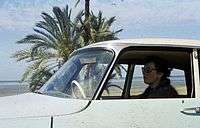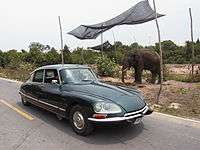Citroën DS
| Citroën DS | |
|---|---|
%2C_by_Klugschnacker_modified.jpg) | |
| Overview | |
| Manufacturer | Citroën |
| Also called |
Citroën DS 19 / DS 21 / DS 23 Citroën D Special Citroën D Super Citroën ID 19 / ID 21 |
| Production |
1955–1975 1,455,746 (worldwide) 1,330,755 (France) |
| Assembly |
Paris, France Heidelberg, Victoria, Australia[1] Mangualde, Portugal Slough, England, United Kingdom Johannesburg, South Africa Koper, Slovenia, Yugoslavia |
| Designer | Flaminio Bertoni |
| Body and chassis | |
| Class | Mid-size luxury / Executive car (E) |
| Body style |
4-door sedan 5-door Safari station wagon 2-door convertible |
| Layout | MF layout |
| Related | Citroën SM |
| Powertrain | |
| Engine |
|
| Transmission |
3-speed automatic 4-speed manual 5-speed manual 4-speed semi-automatic |
| Dimensions | |
| Wheelbase | 3,124 mm (123.0 in)[2] |
| Length |
4,826 mm (190.0 in) (saloon) 4,991 mm (196.5 in) (estate) |
| Width | 1,791 mm (70.5 in) |
| Height |
1,464 mm (57.6 in) (saloon) 1,537 mm (60.5 in) (estate) |
| Curb weight |
1,270 kg (2,800 lb)(saloon) 1,384 kg (3,051 lb)(estate) |
| Chronology | |
| Predecessor | Citroën Traction Avant |
| Successor | Citroën CX |
The Citroën DS (French pronunciation: [si.tʁɔ.ˈɛn de ɛs]) is a front-engine, front-wheel-drive executive car manufactured and marketed by the French company Citroën from 1955 to 1975 in sedan, wagon/estate and convertible body configurations. Italian sculptor and industrial designer Flaminio Bertoni and the French aeronautical engineer André Lefèbvre styled and engineered the car. Paul Magès developed the hydropneumatic self-levelling suspension.
Noted for its aerodynamic, futuristic body design and innovative technology, the DS set new standards in ride quality, handling, and braking[3]—and was the first production car equipped with disc brakes.[4]
Citroën sold 1,455,746 examples, including 1,330,755 built at the manufacturer's Paris Quai André-Citroën production plant.[5]
The DS placed third in the 1999 Car of the Century poll recognizing the world's most influential auto designs and was named the most beautiful car of all time by Classic & Sports Car magazine.[6]
Model history
After 18 years of secret development as the successor to the Traction Avant, the DS 19 was introduced on 5 October 1955 at the Paris Motor Show. In the first 15 minutes of the show, 743 orders were taken, and orders for the first day totalled 12,000.[7] During the 10 days of the show, the DS took in 80,000 deposits; a record that has stood for over 60 years.[8]
Contemporary journalists said the DS pushed the envelope in the ride vs. handling compromise possible in a motor vehicle.[9][10][11]
To a France still deep in reconstruction after the devastation of World War II, and also building its identity in the post-colonial world, the DS was a symbol of French ingenuity.[12] The DS was distributed to many territories throughout the world.[13]
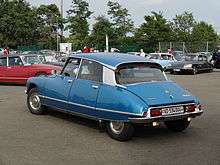
It also posited the nation's relevance in the Space Age, during the global race for technology of the Cold War.[12] Structuralist philosopher Roland Barthes, in an essay about the car, said that it looked as if it had "fallen from the sky".[14] An American advertisement summarised this selling point: "It takes a special person to drive a special car".[15]
Because they were owned by the technologically aggressive tire manufacturer Michelin, Citroën had designed their cars around the technically superior radial tire since 1948, and the DS was no exception.[16][17]
The car featured a novel hydropneumatic suspension including an automatic leveling system and variable ground clearance,[18] developed in-house by Paul Magès. This suspension allowed the DS to travel quickly on the poor road surfaces common in France.[19]
In addition, the vehicle had power steering and a semi-automatic transmission (the transmission required no clutch pedal, but gears still had to be shifted by hand[20]), though the shift lever controlled a powered hydraulic shift mechanism in place of a mechanical linkage, and a fibreglass roof which lowered the centre of gravity and so reduced weight transfer. Inboard front brakes (as well as independent suspension) reduced unsprung weight. Different front and rear track widths and tyre sizes reduced the unequal tyre loading, which is well known to promote understeer, typical of front-engined and front-wheel drive cars.[21]
As with all French cars, the DS design was affected by the tax horsepower system, which effectively mandated very small engines. Unlike the Traction Avant predecessor, there was no top-of-range model with a powerful six-cylinder engine. Citroën had planned an air-cooled flat-6 engine for the car, but did not have the funds to put the prototype engine into production.
The DS placed third in the 1999 Car of the Century competition, and fifth on Automobile Magazine's "100 Coolest Cars" listing in 2005.[22] It was also named the most beautiful car of all time by Classic & Sports Car magazine after a poll of 20 world-renowned car designers, including Giorgetto Giugiaro, Ian Callum, Roy Axe, Paul Bracq, and Leonardo Fioravanti.[6]
Name
Both the DS and its simpler sibling, the ID, used a punning name. "DS" is pronounced in French as "Déesse" (goddess); "ID" is pronounced as "Idée" (idea). An intermediate model was called the DW.[23]
Motorsport

The DS was successful in motorsports like rallying, where sustained speeds on poor surfaces are paramount, and won the Monte Carlo Rally in 1959. In the 1000 Lakes Rally, Pauli Toivonen drove a DS19 to victory in 1962.
In 1966, the DS won the Monte Carlo Rally again, with some controversy as the competitive BMC Mini-Cooper team was disqualified due to rule infractions. Ironically, Mini was involved with DS competition again two years later, when a drunk driver in a Mini in Sydney Australia crashed into the DS that was leading the 1968 London–Sydney Marathon, 98 miles from the finish line.[24] The DS was still competitive in the grueling 1974 London-Sahara-Munich World Cup Rally, where it won over 70 other cars, only 5 of which even completed the entire event.[25][26]
Technical innovation – hydraulic systems
_02.jpg)
In conventional cars, hydraulics are only used in brakes and power steering. In the DS they were also used for the suspension, clutch and transmission. The cheaper 1957 ID19 did have manual steering and a simplified power-braking system. An engine driven pump pressurizes the closed system to 2,400 pounds per square inch. [27]
At a time when few passenger vehicles had independent suspension on all wheels, the application of the hydraulic system to the car's suspension system to provide a self-levelling system was an innovative move. This suspension allowed the car to achieve sharp handling combined with very high ride quality, frequently compared to a "magic carpet".[28][29]
The hydropneumatic suspension used was pioneered the year before, on the rear of another car from Citroën, the top of range Traction Avant 15CV-H.
Impact on Citroën brand development
The 1955 DS cemented the Citroën brand name as an automotive innovator, building on the success of the Traction Avant, which had been the world's first mass-produced unitary body front-wheel-drive car in 1934.[30] In fact, the DS caused such a huge sensation that Citroën was apprehensive that future models would not be of the same bold standard. No clean sheet new models were introduced from 1955 to 1970.
The DS was a large, expensive[31] executive car and a downward brand extension was attempted, but without result. Throughout the late 1950s and 1960s Citroën developed many new vehicles for the very large, profitable market segments between the 2CV and the DS, occupied by vehicles like the Peugeot 403, Renault 16 and Ford Cortina, but none made it into production.[32][33][34] Either they had uneconomic build costs, or were ordinary "me too" cars, not up to the company's high standard of innovation. As Citroën was owned by Michelin from 1934 to 1974 as a sort of research laboratory, such broad experimentation was possible. Michelin after all was getting a powerful advertisement for the capabilities of the radial tire Michelin had invented, when such experimentation was successful.
New models based on the small, utilitarian 2CV economy car were introduced, notably the 1961 Ami. It was also designed by Flaminio Bertoni and aimed to combine Three-box styling with the chassis of the 2CV. The Ami was very successful in France, but less so on export markets. Many found the styling controversial, and the car noisy and underpowered.[35] The Dyane, was a modernised 2CV with a hatchback, competed with the 2CV inspired Renault 4 Hatchback. All these 2 cylinder models were very small, so there remained a wide market gap to the DS range all through the 1960s.
In 1970, Citroën finally introduced a car to target the mid-range - the Citroën GS, which won the "European car of the Year" for 1971 and sold 2.5 million units. It combined a small 55 horsepower flat-4 air-cooled engine with Hydropneumatic suspension. The intended 106 horsepower Wankel rotary-engined version with more power did not reach full production.
Replacing the DS
The DS remained popular and competitive throughout its production run. Its peak production year was 1970. Certain design elements like the somewhat narrow cabin, column-mounted gearstick, and separate fenders began to seem a little old-fashioned in the 1970s.
Citroën invested enormous resources to design and launch an entirely new vehicle in 1970, the SM, which was in effect a thoroughly modernized DS, with similar length, but greater width. The manual gearbox was a modified DS unit. The front disc brakes were the same design. Axles, wheel bearings, steering knuckles, and hydraulic components were either DS parts or modified DS parts.[36]
The SM had a different purpose than replacing the 15-year-old DS design however - it was meant to launch Citroën into a completely new luxury grand touring market segment. Only fitted with a costly, exotic Maserati engine, the SM was faster and much more expensive than the DS. The SM was not designed to be a practical 4-door saloon suitable as a large family car, the key market for vehicles of this type in Europe. Typically, manufacturers would introduce low-volume coupés based on parts shared with an existing saloon, not as unique models, a contemporary example being the Mercedes-Benz SLC-Class.[37]
The SM's high price and limited utility of the 2+2 seating configuration, meant the SM as actually produced could not seize the mantle from the DS.
So, while the design funds invested would allow the DS to be replaced by two cars - a 'modern DS' and the smaller CX, it was left to the CX alone to provide Citroën's large family or executive car in the model range.[5]
The last DS came off the production line on 24 April 1975 - the manufacturer had taken the elementary precaution of building up approximately eight-month's of inventory of the "break" (estate/station wagon) version of the DS, to cover the period till Autumn 1975 when the estate/station wagon version of the CX would be introduced.[5]
Development
The DS always maintained its size and shape, with easily removable, unstressed body panels, but certain design changes did occur. During the 20-year production life improvements were made on an ongoing basis.
ID 19 submodel to extend brand downwards (1957–69)
The 1955 DS19 was 65% more expensive than the car it replaced, the Citroën Traction Avant.[38] This affected potential sales in a country still recovering economically from World War II, so a cheaper submodel, the Citroën ID, was introduced in 1957.
The ID shared the DS's body but was less powerful and luxurious. Although it shared the engine capacity of the DS engine (at this stage 1,911 cc), the ID provided a maximum power output of only 69 hp compared to the 75 hp claimed for the DS19.[39] Power outputs were further differentiated in 1961 when the DS19 acquired a Weber-32 twin bodied carburettor, and the increasing availability of higher octane fuel enabled the manufacturer to increase the compression ratio from 7.5:1 to 8.5:1.[39] A new DS19 now came with a promised 83 hp of power.[39] The ID19 was also more traditional mechanically: it had no power steering and had conventional transmission and clutch instead of the DS's hydraulically controlled set-up. Initially the basic ID19 was sold on the French market with a price saving of more than 25% against the DS, although the differential was reduced at the end of 1961 when the manufacturer quietly withdrew the entry level ID19 "Normale" from sale.[39] A station wagon variant, the ID Break, was introduced in 1958.
D Spécial and D Super (1970–75)
The ID was replaced by the D Spécial and D Super in 1970, but these retained the lower specification position in the range. The D Super was available with the DS21 2175ccm engine and a 5 speed gearbox, and named the D Super 5.
Series 2 - Nose redesign in 1962

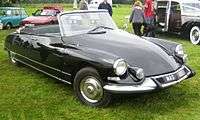

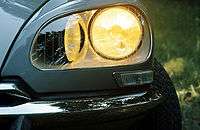
In September 1962, the DS was restyled with a more aerodynamically efficient nose, better ventilation and other improvements. It retained the open two headlamp appearance, but was available with an optional set of driving lights mounted on the front fenders. All models in the range changed nose design at the same time, including the ID and station wagon models.
Series 3 - Nose redesign in 1967 with Directional headlights
In late 1967, for the 1968 model year, the DS and ID was again restyled, by Robert Opron, who also styled the 1970 SM and 1974 CX. This version had a more streamlined headlamp design, giving the car a notably shark-like appearance. This design had four headlights under a smooth glass canopy, and the inner set swivelled with the steering wheel. This allowed the driver to see "around" turns, especially valuable on twisting roads driven at high speed at night.
Behind each glass cover lens, the inboard high-beam headlamp swivels by up to 80° as the driver steers, throwing the beam along the driver's intended path rather than uselessly across the curved road. The outboard low-beam headlamps are self-leveling in response to pitching caused by acceleration and braking.[40]
However, this feature was not allowed in the US at the time (see World Forum for Harmonization of Vehicle Regulations), so a version with four exposed headlights that did not swivel was made for the US market.
This 'turning headlight' feature was new to the market - it had only been seen before on the very rare three headlight 1935 Tatra 77A. The Tucker, which never was mass-produced, had a central headlight that turned with the steering. 45 years later, it is now a commonly available feature, even in the United States.
New Green Hydraulic Fluid
The original hydropneumatic system used a vegetable oil liquide hydraulique végétal (LHV), similar to that used in other cars at the time, but later switched to a synthetic fluid liquide hydraulique synthétique (LHS). Both of these had the disadvantage that they are hygroscopic, as is the case with most brake fluids. Disuse allows water to enter the hydraulic components causing deterioration and expensive maintenance work. The difficulty with hygroscopic hydraulic fluid was exacerbated in the DS/ID due to the extreme rise and fall in the fluid level in the reservoir, which went from nearly full to nearly empty when the suspension extended to maximum height and the six accumulators in the system filled with fluid. With every "inhalation" of fresh moisture- (and dust-) laden air, the fluid absorbed more water.
For the 1967 model year, Citroën introduced a new mineral oil-based fluid LHM (Liquide Hydraulique Minéral). This fluid was much less harsh on the system. LHM remained in use within Citroën until the Xantia was discontinued in 2001.
LHM required completely different materials for the seals. Using either fluid in the incorrect system would completely destroy the hydraulic seals very quickly. To help avoid this problem, Citroën added a bright green dye to the LHM fluid and also painted all hydraulic elements bright green. The former LHS parts were painted black.
All models, including the station wagon and ID, were upgraded at the same time. The hydraulic fluid changed to the technically superior LHM in all markets except the US and Canada, where the change did not take place until January 1969, due to local regulations.
International sales and production
The DS was primarily manufactured at the Quai André-Citroën in the Javel neighborhood of Paris, with other manufacturing facilities in the United Kingdom, South Africa, the former Yugoslavia (mostly Break Ambulances), and Australia.
Australia constructed their own D variant in the 1960s at Heidelberg, Victoria, identified as the ID 19 "Parisienne."[41] Australian market cars were fitted with options as standard equipment such as the "DSpecial DeLuxe" that were not available on domestic European models.
Until 1965, cars were assembled at the manufacturer's Slough premises, to the west of London, using a combination of French made knock down kits and locally sourced components, some of them machined on site.[42] A French electrical system superseded the British one on the Slough cars in 1962, giving rise to a switch to "continental style" negative earthing. After 1965 cars for the British market were imported fully assembled from the company's French plant.[42] The British-built cars are distinguished by their leather seats, wooden (early ID19 models) one piece plastic (early DS19 models) dashboards, chromed number plate mount let into the front bumper, and (on pre-1962 cars) Lucas-made electrics. These were all right hand drive cars.
The DS was built and sold in South Africa from 1959 to 1975.[43]
The DS was sold in Japan, but the models were built in France and left hand drive.[44]
DS in North America

The DS was sold in North America from 1956 to 1972. Despite its popularity in Europe, it didn't sell well in the United States, and little better in Canada. While promoted as a luxury car, it did not have the basic features that American buyers expected to find on such a vehicle, such as an automatic transmission, air conditioning, power windows, or a powerful engine.[45] The DS was designed specifically to address the French market, with punitive tax horsepower taxation of large engines, as well as very poor roads – it's no great mystery that it was a fish out of water when those constraints were removed.[46]
Jay Leno described the sporadic supply of spare parts as a problem for 1970s era customers, based on his early experiences working at a Citroën dealer in Boston.[47]
The DS was expensive, with a 115 hp (86 kW) vehicle costing $4,170 in 1969,[48] when the price was $4,500 for a 360 hp (268 kW) Buick Electra 225 4 door sedan.[49] For all years, 38,000 units were sold.
US regulations at the time also banned one of the car's more advanced features: its composite headlamps with aerodynamic covered lenses. Based on legislation that dated from 1940, all automobiles sold in the U.S. were required to have round, sealed beam headlamps that produced a meager 75,000 candlepower.[50] The powerful quartz iodine swiveling headlamps designed for the 1968 model DS represented so many performance improvements at once that they were far beyond what the regulations could allow.[51] Even the aerodynamic headlight covers were illegal – as seen on the 1968 Jaguar E-Type. It took the lobbying muscle of Ford to point out that the government was requiring two contradictory things – safety, by ensuring that all headlights were best-of-breed circa 1940, and fuel economy through the CAFE standard – by definition, cars with poor aerodynamics are sacrificing fuel economy.[46] Composite bulb lamps and aerodynamic covered headlights were not permitted until 1983.
The European lamps were legal in Canada, including the directional headlamps.[52]
The hydraulic fluid change in 1967 was another brain teaser for U.S. automotive regulators at the Department of Transportation. NHTSA follows the precautionary principle, also used by the Food and Drug Administration, where new innovations are prohibited until their developers can prove them to the regulators; this stifles the experimentation that automakers need to advance their products.[53] NHTSA had already approved a brake fluid they considered safe – DOT 3 brake fluid, which is red and hygroscopic to promote internal rust. This completely different fluid, used in aircraft applications – the technically superior green LHM (Liquide Hydraulique Mineral) – took NHTSA two years to analyze for automotive use. Approval finally came in January 1969, so half the U.S. cars of the 1969 model year use red fluid and half use green fluid.[54]
Design variations



Pallas
In 1965 a luxury upgrade, the DS Pallas (after Greek goddess Pallas), was introduced. This included comfort features such as better noise insulation, a more luxurious (and optional leather) upholstery and external trim embellishments. From 1966 the Pallas model received a driver's seat with height adjustment.
Station Wagon, Familiale, and Ambulance
A station wagon version was introduced in 1958. It was known by various names in different markets (Break in France, Safari and Estate in the UK, Wagon in the US, and Citroën Australia used the terms Safari and Station-Wagon). It had a steel roof to support the standard roof rack. 'Familiales' had a rear seat mounted further back in the cabin, with three folding seats between the front and rear squabs. The standard Break had two side-facing seats in the main load area at the back.
The Ambulance configuration was similar to that of the Break, but with a 60/30 split in the rear folding seat to accommodate a stretcher. A 'Commerciale' version was also available for a time.
The Safari saw use as a camera car, notably by the BBC.[55] The hydropneumatic suspension produces an unusually steady platform for filming while driving.[56]
Convertible
Rarest and most collectable of all DS variants, a convertible was offered from 1958 until 1973. The Cabriolet d'Usine (factory convertible) were built by French carrossier Henri Chapron, for the Citroën dealer network. It was an expensive car, so only 1,365 were sold.[57] These DS convertibles used a special frame which was reinforced on the sidemembers and rear suspension swingarm bearing box, similar to, but not identical to the Break (Station Wagon) frame.
Chapron variations
In addition, Chapron also produced a few coupés, non-works convertibles and special sedans (including the "Prestige",[58] same wheelbase but with a central divider, and the "Lorraine" notchback).
Bossaert Coupe
Between 1959 and 1964, Hector Bossaert produced a coupé on a DS chassis shortened by 470 mm (18 1⁄2 inches).[59] While the front end remained unchanged, the rear end featured notchback styling.[59]
The Reactor
In 1965, noted American auto customizer Gene Winfield created The Reactor, a Citroën DS chassis, with a turbocharged 180 hp (130 kW) flat-six engine from the Corvair driving the front wheels.[60] Since the DS already had the engine behind the front wheels, the longer engine meant only one row of seats. This was draped in a streamlined, low slung, aluminum body.
The Reactor was seen in American Television programs of the era, such as Star Trek: The Original Series episode 2.25 ("Bread and Circuses)," Batman episodes 110 ("Funny Feline Felonies") and 111 (driven by Catwoman Eartha Kitt),[61] and Bewitched, which devoted its episode 3.19 ("Super Car") to The Reactor.[62]
Michelin PLR
The Michelin PLR is a mobile tire evaluation machine, based on the DS Break, built in 1972, later used for promotion.
Technical details

.jpg)

Suspension
In a hydropneumatic suspension system, each wheel is connected, not to a spring, but to a hydraulic suspension unit consisting of a hydraulic accumulator sphere of about 12 cm in diameter containing pressurised nitrogen, a cylinder containing hydraulic fluid screwed to the suspension sphere, a piston inside the cylinder connected by levers to the suspension itself, and a damper valve between the piston and the sphere.[63] A membrane in the sphere prevented the nitrogen from escaping. The motion of the wheels translated to a motion of the piston, which acted on the oil in the nitrogen cushion and provided the spring effect. The damper valve took place of the shock absorber in conventional suspensions. The hydraulic cylinder was fed with hydraulic fluid from the main pressure reservoir via a height corrector, a valve controlled by the mid-position of the anti-roll bar connected to the axle. If the suspension was too low, the height corrector introduced high-pressure fluid; if it was too high, it released fluid back to the fluid reservoir. In this manner, a constant ride height was maintained. A control in the cabin allowed the driver to select one of five heights: normal riding height, two slightly higher riding heights for poor terrain, and two extreme positions for changing wheels. (The correct term, oleopneumatic (oil-air), has never gained widespread use. Hydropneumatic (water-air) continues to be preferred overwhelmingly.)
The DS did not have a jack for lifting the car off the ground. Instead, the hydraulic system enabled wheel changes with the aid of a simple adjustable stand. To change a flat tyre, one would adjust the suspension to its topmost setting, insert the stand into a special peg near the flat tyre, then readjust the suspension to its lowermost setting. The flat tyre would then retract upwards and hover above ground, ready to be changed.[64] This system, used on the SM also, was superseded on the CX by a screw jack that, after the suspension was raised to the high position, lifted the tire clear of the ground. The DS system, while impressive to use, sometimes dropped the car quite suddenly, especially if the stand was not placed precisely or the ground was soft or unlevel.
Source and reserve of pressure
The central part of the hydraulic system was the high pressure pump, which maintained a pressure of between 130 and 150 bar in two accumulators. These accumulators were very similar in construction to the suspension spheres. One was dedicated to the front brakes, and the other ran the other hydraulic systems. (On the simpler ID models, the front brakes operated from the main accumulator.) Thus in case of a hydraulic failure, the first indication would be that the steering became heavy, followed by the gearbox not working; only later would the brakes fail.
Two different hydraulic pumps were used. The DS used a seven-cylinder axial piston pump driven off two belts and delivering 175 bar (2,540 psi) of pressure. The ID19, with its simpler hydraulic system, had a single-cylinder pump driven by an eccentric on the camshaft.
Gearbox and clutch
Hydraulique or Citromatic
The DS was initially offered only with the "hydraulique" four-speed semi-automatic (bvh—"boîte de vitesses hydraulique") gearbox.[63]
This was a four-speed gearbox and clutch, operated by a hydraulic controller. To change gears, the driver flicked a lever behind the steering wheel to the next position and eased-up on the accelerator pedal. The hydraulic controller disengaged the clutch, engaged the nominated gear, and re-engaged the clutch. The speed of engagement of the clutch was controlled by a centrifugal regulator sensing engine rpm and driven off the camshaft by a belt, the position of the butterfly valve in the carburettor (i.e., the position of the accelerator), and the brake circuit. When the brake was pressed, the engine idle speed dropped to an rpm below the clutch engagement speed, thus preventing friction while stopped in gear at traffic lights. When the brake was released, the idle speed increased to the clutch dragging speed. The car would then creep forward much like automatic transmission cars. This drop in idle throttle position also caused the car to have more engine drag when the brakes were applied even before the car slowed to the idle speed in gear, preventing the engine from pulling against the brakes. In the event of loss of hydraulic pressure (following loss of system fluid), the clutch would disengage, to prevent driving, while brake pressure reserves would allow safe braking to standstill.
Manual—four-speed and five-speed
The later and simpler ID19 had the same gearbox and clutch, manually operated. This configuration was offered as a cheaper option for the DS in 1963. The mechanical aspects of the gearbox and clutch were completely conventional and the same elements were used in the ID 19. In September 1970, Citroën introduced a five-speed manual gearbox, in addition to the original four-speed unit.[65]
Fully automatic
In September 1971 Citroën introduced a 3-speed fully automatic Borg-Warner 35 transmission gearbox, on the DS 21 and later DS 23 models.[66] It is ironic that the fully automatic transmission DS was never sold in the US market, where this type of transmission had gained market share so quickly that it became the majority of the market by this time. Many automatic DSs, fuel-injected DS 23 sedans with air conditioning, were sold in Australia.
Engines
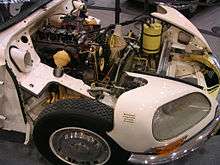
The DS was originally designed around an air-cooled flat-six based on the design of the 2-cylinder engine of the 2CV, similar to the motor in the Porsche 911. Technical and monetary problems forced this idea to be scrapped.
Thus, for such a modern car, the engine of the original DS 19 was also old-fashioned. It was derived from the engine of the 11CV Traction Avant (models 11B and 11C).[67] It was an OHV four-cylinder engine with three main bearings and wet liners, and a bore of 78 mm (3.1 in) and a stroke of 100 mm (3.9 in), giving a volumetric displacement of 1911 cc. The cylinder head had been reworked; the 11C had a reverse-flow cast iron cylinder head and generated 60 hp (45 kW) at 3800 rpm; by contrast, the DS 19 had an aluminium cross-flow head with hemispherical combustion chambers and generated 75 hp (56 kW) at 4500 rpm.
Like the Traction Avant, the DS had the gearbox mounted in front of the engine, with the differential in between. Thus some consider the DS to be a mid engine front-wheel drive car.[67]
The DS and ID powerplants evolved throughout its 20-year production life. The car was underpowered and faced constant mechanical changes to boost the performance of the four-cylinder engine. The initial 1911 cc three main bearing engine (carried forward from the Traction Avant) of the DS 19 was replaced in 1965 with the 1985 cc five-bearing wet-cylinder motor, becoming the DS 19a (called DS 20 from September 1969).
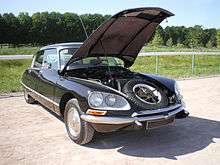
The DS 21 was also introduced for model year 1965. This was a 2175 cc, five main bearing engine; power was 109 hp[20] This engine received a substantial increase in power with the introduction of Bosch electronic fuel injection for 1970, making the DS one of the first mass-market cars to use electronic fuel injection. Power of the carbureted version also increased slightly at the same time, owing to the employment of larger inlet valves.
Lastly, 1973 saw the introduction of the 2347 cc engine of the DS 23 in both carbureted and fuel-injected forms. The DS 23 with electronic fuel injection was the most powerful production model, producing 141 hp (105 kW).[68]
IDs and their variants went through a similar evolution, generally lagging the DS by about one year. ID saloon models never received the DS 23 engine or fuel injection, although the Break/Familiale versions received the carburetted version of the DS 23 engine when it was introduced, supplemented the DS20 Break/Familiale.
The top of the range ID model, The DSuper5 (DP) gained the DS21 engine (the only model that this engine was retained in) for the 1973 model year and it was mated to a five-speed gearbox. This should not be confused with the 1985 cc DSuper fitted with an optional "low ratio" five-speed gearbox, or with the previous DS21M (DJ) five-speed.
In popular culture
President Charles de Gaulle survived an assassination attempt at Le Petit-Clamart near Paris on August 22, 1962, planned by Algerian War veteran Jean-Marie Bastien-Thiry. The plan was to ambush the motorcade with machine guns, disable the vehicles, and then close in for the kill. De Gaulle praised the unusual abilities of his unarmoured DS with saving his life – the car was peppered with bullets, and the shots had punctured the tyres, but the car could still escape at full speed.[69] This event was accurately recreated in the 1973 film The Day of the Jackal.

.jpg)
Beyond de Gaulle and the French aristocracy, the roomy DS also appealed to French taxi drivers.
Outside France, the car drew an eclectic customer mix, such as Cosmonaut Yuri Gagarin, Pope John XXIII, painter Marc Chagall, and actors Ken Berry, Jeff Bridges, and Rosamund Pike.[70][71][72][73][74][75]
The DS is featured prominently in Gavin Lyall's 1965 suspense novel "Midnight Plus One" as the "get away car" for a fugitive businessman and his hired bodyguards on a journey from Brittany to Liechtenstein. An ode to Jane Child's DS21 appears on her 1989 self-titled album.[76]
According to Internet Movie Cars Database, the DS/ID has made over 2,000 film and television appearances so far.[77]
After a driverless car chase, a DS transforms into the robot Rodimus Prime in the 2017 film Transformers: The Last Knight.
Several episodes of the 1960's television series Mission: Impossible, featured the DS including substantial appearances in 'The Slave' (ep. 2.06) and 'Robot' (ep. 4.09).
In 1989, the film Back to the Future Part II featured a modified Citroën DS as a flying taxicab, when the main characters travel 30 years into the future (2015). [78]Scarface (1983 film) with Al Pacino and the 2009 television series The Mentalist both feature the DS in key roles.
Two films focus on the DS, The Goddess of 1967 about a Japanese man purchasing a DS (goddess or déesse in French) in Australia, and 1995's Icelandic-Japanese road movie Cold Fever.
Legacy

Citroën DS values have been rising[79] – a 1973 DS 23 Injection Electronique "Decapotable" (Chapron Convertible) sold for EUR €176,250 (USD $209,738) at Christie's Rétromobile in February 2006.[80] and a similar car sold by Bonhams in February 2009 brought EUR €343,497 (USD $440,436).[81] On 18 September 2009 a 1966 DS21 Decapotable Usine was sold by Bonhams for a hammer price of UK£131,300. Bonhams sold another DS21 Decapotable (1973) on 23 January 2010 for EUR €189,000.[82]
The DS's beloved place in French society was demonstrated in Paris on 9 October 2005 with a celebration of the 50th anniversary of its launch. 1,600 DS cars drove in procession past the Arc de Triomphe.[83]
From 2005 to 2008, a young Frenchman named Manuel Boileau travelled around the world in a 1971 DS ambulance. It was an 80,000 kilometer journey across 38 countries called Lunaya World Tour. While traveling through Laos, he located the forlorn 1974 DS Prestige belonging to Sisavang Vatthana, the last King of the Kingdom of Laos, which is now preserved and restored by specialists in Bangkok.[84]
In 2009, Groupe PSA created a new brand - DS Automobiles, intended as high quality, high specification variations on existing models, with differing mechanics and bodywork.[85] This brand ranges across four models, the DS3, DS4, DS5, and the China-only SUV DS 6. The DS3, launched in March 2010, is based on Citroën's new C3, but is more customisable and unique, bearing some resemblance to the original DS, with its "Shark Fin" side pillar. These have created their own niches, with the DS4 being a mix of a crossover and a coupe and the DS5 mixing a coupe and an estate. Many feature hybrid-diesel engines to maximise efficiency.
Production figures
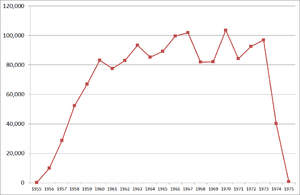
- 1955: 69
- 1956: 9,868
- 1957: 28,593
- 1958: 52,416
- 1959: 66,931
- 1960: 83,205
- 1961: 77,597
- 1962: 83,035
- 1963: 93,476
- 1964: 85,379
- 1965: 89,314
- 1966: 99,561
- 1967: 101,904
- 1968: 81,860
- 1969: 82,218
- 1970: 103,633
- 1971: 84,328
- 1972: 92,483
- 1973: 96,990
- 1974: 40,039
- 1975: 847[86]
See also
- Road & Track magazine, USA. June 1958.
- Tatra 77
References
- ↑ Citroën D-models in Australia, by le docteur Danche Retrieved on 27 June 2012
- ↑ "955-1975 Citroen DS 19/20/21/23". How Stuff Works. Retrieved 5 October 2016.
- ↑ "Citroen DS – A car years ahead of its time". retrothing.com. Retrieved 6 September 2007.
- ↑ Hemmings.com. "The first car with disc brakes really was . . . | Hemmings Motor News". hemmings.com. Retrieved 1 September 2015.
- 1 2 3 "Automobilia". Toutes les voitures françaises 1975 (salon Paris Oct 1974). Paris: Histoire & collections. Nr. 72: 24. 2005.
- 1 2 "1955 Citroen DS – The Most Beautiful Car of All Time". Motorcities.com. Retrieved 9 July 2009.
- ↑ "The Most Incredible Car Ever Built". egothemag.com. Retrieved 6 September 2007.
- ↑ Randall, Tom (2016-04-21). "Ten Charts That Will Make You Rethink Tesla's Model 3". Bloomberg News. Retrieved 2016-05-07.
- ↑ "AutoSpeed - The Amazing Citroen DS". autospeed.com. Retrieved 1 September 2015.
- ↑ "Drive: 1960 Citroen DS". motortrend.com. Retrieved 6 September 2007.
- ↑ "Road Test: Citroën The DS-19 drives boldly off the beaten path – and never feels the bumps". Road & Track. November 1956. Retrieved 22 July 2017.
- 1 2 Fifty Cars That Changed the World by Design Museum, 2010, ISBN 978-1840915365
- ↑ Pierre Jammes. "Citroen DS in Asia". Dsinasia.com. Retrieved 28 November 2011.
- ↑ "The New Citroen by Roland Barthes 1957". id-ds.com. Archived from the original on 16 August 2007. Retrieved 6 September 2007.
- ↑ "Toronto car enthusiast owns France’s topless ‘goddess’". The Globe and Mail.
- ↑ "Car History 4U - History of the car tire in Motor Cars / Automobiles". carhistory4u.com. Retrieved 1 September 2015.
- ↑ "A Tale of Two Tires - Businessweek". bloomberg.com. Retrieved 1 September 2015.
- ↑ "...gliding on air with only the flick of the speedometer needle to remind you you're in motion! No bumping, jerking, dragging, lurching." From an ad for the Citroën stand at the Motor Show, London, 1957
- ↑ Citroen DS: Design Icon By Malcolm Bobbit , 2005, ISBN 9781904788300, page 32
- 1 2 Willson, Quentin (1995). The Ultimate Classic Car Book. DK Publishing, Inc. ISBN 0-7894-0159-2.
- ↑ Artcurial Motorcars à Rétromobile (Vente no 1957), Paris, France: Artcurial-Briest-Poulain-F.Tajan, 4 February 2011, p. 94
- ↑ "Automobile Magazine – 100 Coolest Cars". Retrieved 29 July 2008.
- ↑ Motor Road Tests 1964 Edition
- ↑ "1968 London - Sydney Marathon".
- ↑ "CUAS - UDT 1974 London-Sahara-Münich World Cup Rally".
- ↑ Fairfax Regional Media (31 March 2013). "Sherrard rallies to help in devil appeal". The Examiner.
- ↑ "Rallying a classic Citroën DS | Cars". telegraph.co.uk. Retrieved 1 September 2015.
- ↑ "1972 Citroen DS 21". Vintage Kraft.
- ↑ "Citroen DS3: The new version of ‘cool’". caradvice.com.au. Retrieved 1 September 2015.
- ↑ "The machines that shaped a century". Stuff.
- ↑ http://www.facel-vega.com/mageng1.shtml DS cost 42% more than Peugeot 403 in 1956
- ↑ "Citroën Cocinelle C1 - C8".
- ↑ "Citroën C 60".
- ↑ "Citroën Projet F (Projet AP)".
- ↑ "Citroen Ami 6 Road Test 1962". Flickr.
- ↑ Citroën SM parts and repair manuals
- ↑ Mercedes-Benz Buyer's Guide, Fred Larimer, 2004, ISBN 978-0760318119 Page 81
- ↑ Citroen DS: Design Icon By Malcolm Bobbit , 2005, ISBN 9781904788300, page 64
- 1 2 3 4 Bellu, René (2001). "Automobilia". Toutes les voitures françaises 1962 (salon Paris Oct 1961). Paris: Histoire & collections (19): 15.
- ↑ Autocar Road Test No. 2056; December 3, 1965
- ↑ ID 19 "Parisienne", made in Heidelberg, Australia Retrieved on 14 August 2012
- 1 2 "Spot check: The Citroen D-Type". Motor. 21 August 1971. pp. 38–40.
- ↑ "Made in South Africa/Vervaarding in Suid-Afrika". Citroenet.org.uk. Retrieved 16 June 2016.
- ↑ "Japan". DSinAsia.com. Retrieved 16 June 2016.
- ↑ http://www.voxprof.com/eden/Publications/madeinustheusautoindustry.pdf page 513
- 1 2 "Citroën DS, a Classic Car 20 Years Ahead of its Time". Archived from the original on 4 January 2007.
- ↑ "1971 Citröen DS | Video | Jay Leno's Garage | NBC". nbc.com. Retrieved 1 September 2015.
- ↑ "1969 Citroen DS21 Technical Specifications and data. Engine, Dimensions and Mechanical details. (DS21, D21, Aero Super, Luxe, Confort, DS 21, Grande Rte, Luxe D21, D19, Pallas) | Conceptcarz.com". conceptcarz.com. Retrieved 1 September 2015.
- ↑ "1969 Buick Electra 225 Custom Specifications". conceptcarz.com. Retrieved 16 June 2016.
- ↑ Whitely, Peyton The Seattle Times How Bright Really Right In Today's Headlight? April 24, 1992 Retrieved 17 July 2015.
- ↑ Angela Greiling Keane (28 March 2013). "Audi Wants to Change a 45-Year-Old U.S. Headlight Rule". BloombergBusinessweek. Retrieved 22 August 2016.
- ↑ "Would Canada welcome back pioneering Citroen?". Driving.ca. Retrieved 16 June 2016.
- ↑ L. Gordon Crovitz (21 August 2016). "Humans: Unsafe at Any Speed". Wall Street Journal. Retrieved 22 August 2016.
- ↑ "Citroen Concours of America's Citroen '66 to '72 DS/ID Buyers Guide". Citroën Concours of America. Retrieved 22 August 2016.
- ↑ "Page 159". tech-ops.co.uk. Retrieved 1 September 2015.
- ↑ Top Gear, series 8, episode 5
- ↑ "1966 Citroen DS21 (DS21, D21, Aero Super, Luxe, Confort, DS 21, Grande Rte, Chapron, Decapotable) | Conceptcarz.com". conceptcarz.com. Retrieved 1 September 2015.
- ↑ "Image: std_1971_Citron_DS_21_Prestige_by_Chapron-3.jpg, (480 × 336 px)". motorbase.com. Retrieved 1 September 2015.
- 1 2 Georgano, Nick (2000). The Beaulieu Encyclopedia of the Automobile. London: Stationery Office. p. 1792. ISBN 0117023191.
- ↑ Grant, David (2008). The Legendary Custom Cars and Hot Rods of Gene Winfield. Motorbooks. ISBN 978-0-7603-2778-4.
- ↑ "9 Old School Batman Vehicles That Rocked". Breakdowncover.org. 3 March 2010. Retrieved 28 November 2011.
- ↑ "The Reactor - Gene Winfield". Fotki - wwww.fotki.com.
- 1 2 http://www.mycitroen.dk/library/ds/Red/Hydraulics/Chas'%20Hydraulic%20Course.pdf
- ↑ Hemmings.com. "Cars of Futures Past – Citroen DS | Hemmings Daily". blog.hemmings.com. Retrieved 1 September 2015.
- ↑ Reynolds, John (1996). Original Citroën DS. Bay View Books. ISBN 1-870979-71-0.
- ↑ http://www.nuancierds.fr/Citroen%20DS%20boite%20Borg%20Warner.htm in French
- 1 2 "Citroën DS the birth of the goddess 3". citroenet.org.uk. Retrieved 1 September 2015.
- ↑ Citroen DS: Design Icon, by Malcolm Bobbit, 2005, ISBN 9781904788300, page 131
- ↑ "Citroen helps De Gaulle survive assassination attempt". History.com.
- ↑ "STAR PARMIS LES STARS". dsidclubdefrance.net. Retrieved 21 June 2016.
- ↑ "Pulmaauto rent - Citroen DS oldtimer".
- ↑ Top Gear. "Tron: Legacy news - TopGear.com meets the stars of Tron: Legacy - 2010 - BBC Top Gear". BBC Top Gear.
- ↑ Laurence Frost (9 August 2011). "Citroen Revival of Historic DS Seen Winning German Premium Drivers: Cars". Bloomberg.
- ↑ "Phil Caron".
- ↑ Ciara Farmer (22 May 2016). "Going, going, nearly Gone Girl! Rosamund Pike narrowly avoids bollard as she whips vintage car around London". Daily Mail. Retrieved 9 August 2016.
- ↑ "Press". Retrieved 21 June 2016.
- ↑ http://www.imcdb.org/vehicles_make-Citro%EBn.html retrieved 14 July 2015.
- ↑ "Automóveis do Futuro - Taxi Luxor Cab Co." (in Portuguese). 6 April 2011. Retrieved 21 June 2016.
- ↑ "1955-1975 Citroën DS - Hemmings Motor News".
- ↑ "2006 Retromobile – Report and Slideshow". Ultimatecarpage.com. Retrieved 28 November 2011.
- ↑ Archived 13 February 2009 at the Wayback Machine.
- ↑ "Citroen DS Decapotable". Motorbase. Retrieved 20 October 2012.
- ↑ "Citroen 'goddess' feted in Paris". BBC News. 9 October 2005. Retrieved 30 April 2010.
- ↑ Pierre Jammes. "Citroen DS in Laos". dsinasia.com. Retrieved 1 September 2015.
- ↑ "Le Monde | Economie | Citroën s'apprêterait à relancer la production de DS". Lemonde.fr. 18 November 2011. Retrieved 28 November 2011.
- ↑ Reynolds, John (1996). Original Citroën DS. Bay View Books. p. 135. ISBN 1-870979-71-0.
External links
| Wikimedia Commons has media related to Citroën DS. |
- Citroën D Series at Citroënët
- Photo of Bossaert DS coupe
- Photos of Gene Winfield's 1965 Reactor
- Citroen DS at the Internet Movie Cars Database
- Maybach SW35 photos for comparison:
| Citroën car timeline, 1950s–1970s — next » | ||||||||||||||||||||||||||||||||||||||||
|---|---|---|---|---|---|---|---|---|---|---|---|---|---|---|---|---|---|---|---|---|---|---|---|---|---|---|---|---|---|---|---|---|---|---|---|---|---|---|---|---|
| Type | 1950s | 1960s | 1970s | |||||||||||||||||||||||||||||||||||||
| 0 | 1 | 2 | 3 | 4 | 5 | 6 | 7 | 8 | 9 | 0 | 1 | 2 | 3 | 4 | 5 | 6 | 7 | 8 | 9 | 0 | 1 | 2 | 3 | 4 | 5 | 6 | 7 | 8 | 9 | |||||||||||
| Economy car | 2CV | |||||||||||||||||||||||||||||||||||||||
| Bijou | ||||||||||||||||||||||||||||||||||||||||
| Off-roader | Méhari | |||||||||||||||||||||||||||||||||||||||
| Supermini | LN / LNA | |||||||||||||||||||||||||||||||||||||||
| Dyane | ||||||||||||||||||||||||||||||||||||||||
| Ami | Visa | |||||||||||||||||||||||||||||||||||||||
| Small family car | GS | |||||||||||||||||||||||||||||||||||||||
| Large family car | 11 CV | ID / DSpécial / DSuper | ||||||||||||||||||||||||||||||||||||||
| Executive car | 15 CV | DS | CX | |||||||||||||||||||||||||||||||||||||
| Grand tourer | SM | |||||||||||||||||||||||||||||||||||||||
